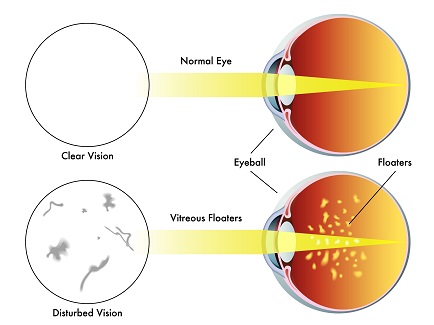
Do you see specks, spots or cobwebs in your field of vision? Chances are, they are floaters. Dr Stephanie Young, Senior Consultant and Director of Ophthalmic Plastic & Reconstructive Surgery at Eagle Eye Centre, sheds light on this common condition.
WHAT ARE FLOATERS?
Eye floaters are spots in your vision. They may look like black or grey specks, strings or cobwebs that drift about when you move your eyes, and appear to dart away when you try to look at them directly.
Floaters may appear as:
• small shapes in your vision that appear as dark specks or knobby, transparent strings of floating material
• spots that move when you move your eyes, so when you try to look at them, they move quickly out of your visual field
• spots that are most noticeable when you look at a plain bright background, such as a blue sky or a white wall
• small shapes or strings that eventually settle down and drift out of the line of vision
WHAT CAUSES THEM?
Most eye floaters are caused by age-related changes in the vitreous, the jelly-like substance that fills the eyeballs and helps to maintain their round shape.
“Over time, the vitreous partially liquefies — a process that causes it to pull away from the eyeball’s interior surface. As the vitreous shrinks and sags, it clumps and gets stringy.
This debris blocks some of the light passing through the eye, casting tiny shadows on your retina that are seen as floaters,” explained Dr Young.
Any activity, such as rapidly moving your eyes to look at something, can stir up these gel clumps and make floaters more noticeable. Exercise that involves pronounced head movements, such as jogging and trampoline jumping, can have the same effect.
WHY DO THEY SEEM TO ONLY OCCUR IN ONE EYE?
Floaters may occur in one or both eyes. The severity may differ in both eyes resulting in asymmetrical symptoms, which can lead patients to think they have floaters in one eye only.
WILL THEY GO AWAY ON THEIR OWN?
For many people, eye floaters do not necessarily go away over time, but become less noticeable when they slowly sink within the vitreous and eventually settle at the bottom of the eye. Once this happens, they stop being noticeable and most people think they have gone away.
WHEN SHOULD YOU SEE A DOCTOR?
The good news is, most of the time floaters are harmless.
An ophthalmologist should be consulted immediately if you notice:
• many more eye floaters than usual
• a sudden onset of new floaters
• flashes of light in the same eye as the floaters
• darkness on any side or sides of your vision (peripheral vision loss)
WHAT SERIOUS UNDERLYING CONDITIONS COULD THEY INDICATE?
Apart from the normal ageing of the vitreous jelly in the eye, floaters may sometimes indicate other eye conditions. Here are some of them.
• Inflammation in the back of the eye, or posterior uveitis, can cause the release of inflammatory debris into the vitreous that are seen as floaters. It may be caused by infection, inflammatory diseases or other causes.
• Bleeding in the eye, caused by diabetes,
hypertension, blocked blood vessels or injury, can release blood cells that are seen as floaters.
• Torn retina, or retinal tears, can occur when a sagging vitreous tugs on the retina with enough force to tear it. Without treatment, a retinal tear may lead to retinal detachment — an accumulation of fluid behind the retina that causes it to separate from the back of your eye. Untreated retinal detachment can cause permanent vision loss.
• Eye surgeries and eye medications that are injected into the vitreous can cause air bubbles to form. These bubbles are seen as shadows until your eye absorbs them. Certain vitreoretinal surgeries add silicone oil bubbles into the vitreous that can also be seen as floaters.
Normal Eye vs. Eye with Floaters

HOW ARE THEY TREATED?
“Sometimes the best treatment is nothing at all. Coping with eye floaters is the least invasive option to protect your eyes,” said Dr Young.
If floaters impair vision and interfere with daily life, a surgical procedure called a vitrectomy can remove them. However, this surgery has its risks and benefits, which should be discussed at length with an ophthalmologist. The surgery should be done by a vitreoretinal surgeon.
During a vitrectomy, the surgeon removes the vitreous through a small incision and replaces it with a solution to maintain the shape of the eye. The body will then produce more vitreous that will eventually replace the solution. Though generally effective, a vitrectomy may not always remove floaters. If the procedure causes bleeding or trauma, they may form again.
Some doctors may also offer laser therapy, which involves aiming lasers at the floaters in order to break them up and reduce their presence. However, this procedure can occasionally result in retinal damage.
“Laser therapy is not the preferred treatment method since it is still experimental. While seen as an effective treatment for some cases, some people have noticed little to no improvement. It can also worsen floaters in some instances,” cautioned Dr Young. “Discuss your options with your doctor before pursuing this method.”
LOOKING OUT FOR YOUR EYES
Although it may not be possible to prevent eye floaters, Dr Young emphasises the importance of following some basic practices to keep the eyes healthy.
“Eat a varied, nutritious diet, quit smoking, wear sunglasses outdoors and protective eyewear when necessary, and avoid potential injury to the eye,” advised Dr Young.
Then, with or without floaters and in the absence of any serious underlying conditions, the future of your eye health should look very bright indeed.
Article contributed by Dr Stephanie Young, an accredited doctor of Mount Alvernia Hospital.
Senior Consultant
Director of Ophthalmic Plastic & Reconstructive Surgery
KK Queck Neurology Centre
Eagle Eye Centre Pte Ltd (EEC)
Medical Centre D #06-57/58/59/60/61/62
Tel: 6456 1000 / 6456 1010
This article is taken from our My Alvernia Magazine Issue #44. Click here to read the issue on our website or on Magzter.